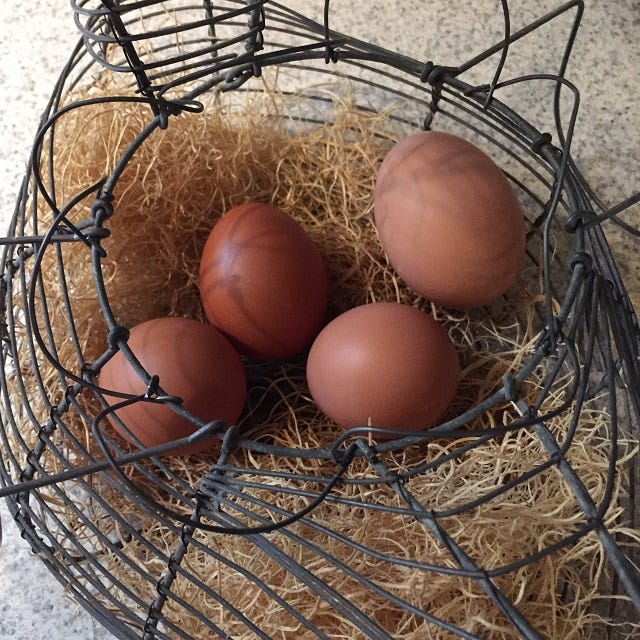Raising chickens for eggs and entertainment
A few permaculture principles can help maintain a flock of layer chickens.
In my last post about choosing livestock that fit your life, I shared that we keep our layer chickens for eggs and entertainment. We enjoy spending time with our chickens, watching the little dramas of their feathered lives, and seeing how they react to the world around them.
Keeping layer chickens essentially kickstarts folks into producing a third of their meals.
If you’re thinking about starting a flock or you already have some girls, managing them with a permaculture mindset helps to make the most of what chickens offer, and can help make keeping them a little easier and self-sustaining.
Permaculture practices with layer chickens
Wagon wheel rotation. If you have the opportunity to select the site of your garden in advance of getting chickens, and your property allows for it, you could set up a mobile coop that rotates around the outside of the garden. (You could also keep the chickens stationary on a future growing space to help build the soil, fertilize, and remove weeds and pests.) This leans on a few permaculture principles: Produce no waste, integrate rather than segregate, use edges, and use slow solutions. Maintaining a flock that rotates around a garden allows them fresh access to forage, keeps them in close proximity to consuming garden waste, and helps to slowly build soil if there are plans for garden expansion or improved pastures for other livestock.
Strategic coop siting. I’ve shared in earlier posts that we started with chickens years before I ever heard the term permaculture. Our coop is stationary and on the complete opposite side of the property from the main garden. A popular strategy with chickens is to keep them adjacent to a garden space both to easily access garden waste and to also take advantage of their own waste to fertilize the garden. Although we missed opportunities to keep the layers with more permaculture practices, this setup inspired me to site the apple orchard and food forest space in between the house and the coop. The compost pile I keep with chicken waste is just a few feet from the orchard, making it easy to keep plants mulched. If you have less flexibility with coop siting, think about how you can strategically choose locations for other systems in relation to your coop.
Rotate with livestock. People commonly rotate chickens behind cows in rotational grazing operations. Fly larvae present in the cow waste take just 2 days to develop. When chickens pass through a space 2 days after cows have grazed, the chickens consume the fly larvae, spread and scratch the waste around, and pick at whatever forage wasn’t favored by the cows. This helps control fly populations and takes advantage of food sources the chickens wouldn’t have had access to otherwise.
Eggs from pasture-raised chickens routinely outperform factory farm-produced eggs nutritionally.
The eggs
Keeping layer chickens essentially kickstarts folks into producing a third of their meals. If your breakfast is egg-based, a small flock of chickens provides plenty to satisfy that meal. An added benefit is that eggs from pasture-raised chickens routinely outperform factory farm-produced eggs nutritionally. (If you were thinking of raising dual-purpose chickens for meat and eggs, the Grassroots Farmers Co-op cites research about pastured chicken nutrition. With less fat, more Vitamin A, and a more favorable omega-3-to-omega-6 fatty acid ratio, the final outcome is considerably superior.) Depending on management practices, you could transition a flock (and also foster genetics if you have roosters) to thrive more on food waste and natural forage than feed purchased from a store or mill. Some people partner with local schools, restaurants, and grocers to collect any food waste and feed it to their chickens (or pigs). FYI This comes with inherent food contamination risks, so I generally encourage folks to thoroughly consider risks and options. You could also grow a grain garden (something I’ve been experimenting with) to supplement or replace and chicken feed purchased off-site.
At some times egg production outpaces consumption. You could choose to sell, trade, or preserve the eggs. I’ve experimented with frozen, dehydrated, and water-glassed eggs.
The entertainment
I find spending time with the chickens more entertaining than most shows or movies. (I’ve heard some people refer to their flock as “Chicken TV.”) At times, the noises they make are their own comedy special. Whether it’s an action movie—a hen finds a baby snake and a few others chase and fight over the snack—or a drama—who’ll get the best spot in the dust bath?—there’s always a new plot unfolding with a flock of chickens.




